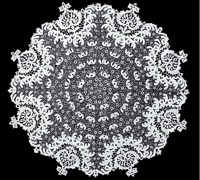Angela Czintelová
The Gemer region has always been known for bobbin lace. At the beginning of the 20th century, crocheted so-called Štítnik laces started to be made in Štítnik. Their production was not based on tradition but it demonstrated an endeavour to support the inhabitants in their uneasy situation after the smith workshops ceased to exist around the Štítnik area. It was artificially created lace with motifs from old Hungarian laces, made by crocheting based on an Irish lace technique.
The first written note about the Štítnik municipality dates from 1243. In the past, the development of the municipality was provided by metal mining and workshops processing the copper ore. The owner of these workshops was the Szontágh family. At that time Štítnik was also known for growing tobacco. Towards the end of the 19th century, the ore mines were exhausted and the industry started to decline.
So in order to have girls and women contribute to the family budget, the eldest daughters of Pavol Szontágh, the former owner of copper workshop, Alžbeta (1856 – 1917) and Aranka (1858 – 1950), based on their mother’s proposal, established a school in their family home in Štítnik in 1905 so girls and women were able to learn to crochet Štítnik laces.
Lace creation did not have any tradition in this municipality. Therefore at the beginning of the 20th century was very favourable for creating laces and clothing accessories. It was a period of secession where laces and decorations were generally very fashionable addition. Szontágh sisters introduced the technique of crocheted Irish lace that was also known as Štítnik lace and adapted it to their style. They tried to cover demand for fashionable accessories on the domestic market which were then imported from Germany, Belgium and Italy. The technique is relatively demanding. It is based on circles that are crocheted around by a thicker thread or by a thread wound up on a stick. Stalks and other parts are crocheted on a thicker leading thread.
The first course started in 1905 and other ones not only in Štítnik but also in nearby cities until 1912. Women made various types of laces on the courses – slim, border, later they made little cloths, collars, cuffs, gloves, ties, ruffles, little covers, altar covers, table cloths with motifs of garnet apples, tulips, cherries – all custom ordered. They were used to decorate clothes, shirts, hats, underwear and for decorating parasols. In 1907 the sisters had already made more than 200 different patterns that they would send to customers and producers free of charge. They would make the laces according to them. The orders were always accompanied by detailed descriptions for creating the lace.
They sold their products in their store in Budapest. Apart from the courses they participated at exhibitions in Hungary as well as abroad with their works. In 1907 and 1908 they published two booklets about Štítnik laces. These were used as a guide for women and girls who wanted to learn this technique.
The activities of the Szontágh sisters lasted until 1914. They were interrupted by WWI and were not renewed after then. In 1996, Vághy Ida from Debrecen started to be involved in this interesting textile technique. She organized several exhibitions during 1999 to 2002 in Hungary. She also organizes camps where she teaches Štítnik lace. In 2004, an association of Štítnik lace (Csetneki Magyar Csipke Alapítvány) was established. Its mission is to devote to the research, implement exhibitions and publishing activities.
